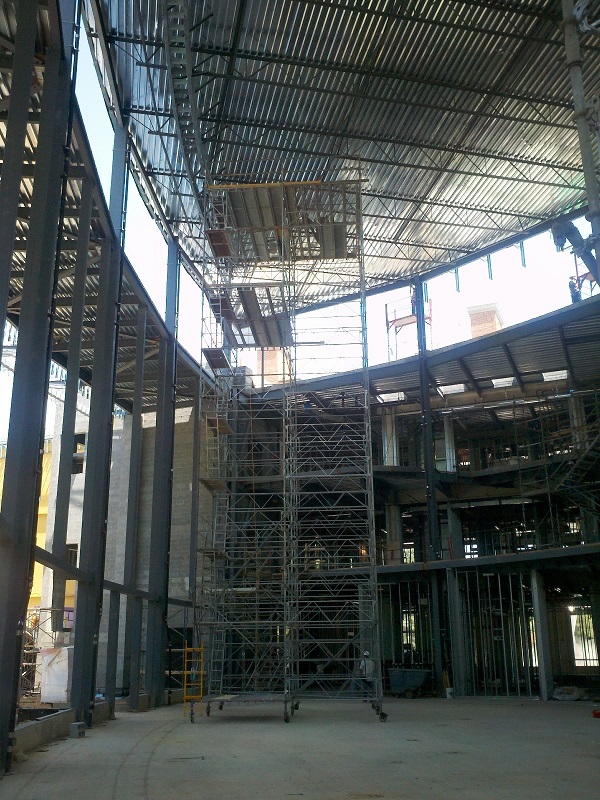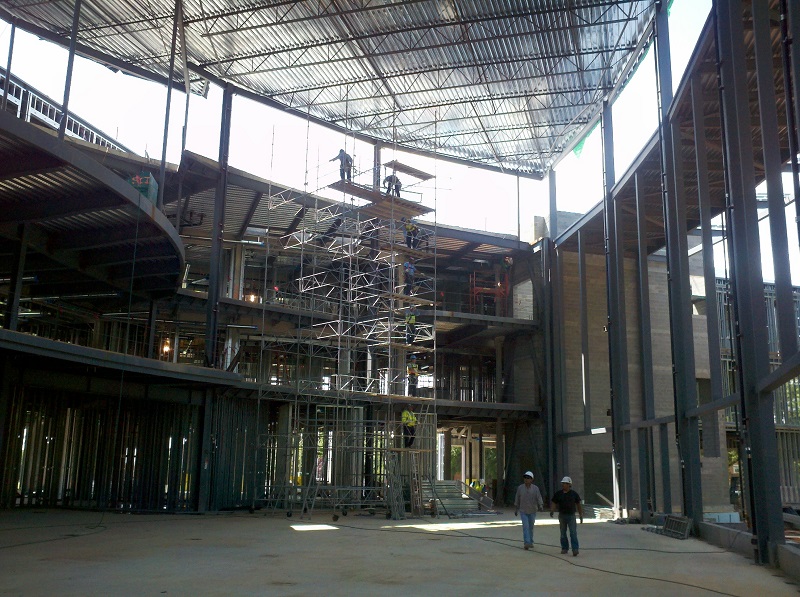 There’s a time and a place for using a scissor lift or rolling tower. For example, when a church needs repairs done high above its altar stage, the first inclination might be to run down to the local equipment rental store and pick up a scissor lift for a few days.
There’s a time and a place for using a scissor lift or rolling tower. For example, when a church needs repairs done high above its altar stage, the first inclination might be to run down to the local equipment rental store and pick up a scissor lift for a few days.
But how exactly do you get a ~4,000lb piece of equipment onto a raised platform in a confined space inside a church? Spoiler: you don’t.
Rolling towers and scissor lifts both provide vertical access to job sites. However, that’s where the similarities end. Read on to learn more about scaffolding vs. scissor lifts and which one you should consider using.
Rolling towers are essentially scaffolds that are about 25 ft high and use castor-style wheels that permit movement of the base. Rolling towers allow workers to safely complete their work over a longer distance than permitted by a stationary scaffold. When workers are on the rolling tower, the wheels manually lock to help ensure a stable work site.
You might hear rolling towers referred by one of several different names, such as:
The biggest advantages of a rolling tower are that they are agile, mobile, and can easily be broken down and moved into any work area that would prevent a scissor lift vehicle from gaining safe access.
For example, rolling towers are the ideal solution when you need to get behind a boiler in a wall cavity where you can’t drive a scissor lift into this confined space. You can maneuver the rolling tower as needed, and the team can access the HVAC or pipe system and get the job done.
Towers are also far lighter than a scissor lift, and they can have a much larger deck, such as 8’ x 8’ or 10’ x 10’. You can also build one in a confined space and roll it back and forth to get to where you need to go.
You should opt for a rolling tower scaffold if:
Going back to the example of the church that we started with, rolling towers are the perfect choice for working in such a space. Churches usually have a small slope going up to the pulpit, so you can’t get a scissor lift into the space even if you take out the pews. The floor is not level, and so the scissor lift would tip over.
But we can build a rolling tower in between the pews and adjust the jack so the tower is level. It can build up to 25 feet, run parallel to the pews, and provide the perfect access for the team to do their work.
Scissor lifts come in many shapes and sizes. From the standard 19’ 2WD lift to the 50’ 4WD models built on a truck chassis, they allow workers to perform their jobs at varying heights while being mobile.
They weigh a lot and are pretty big in physical size, preventing them from accessing smaller confined spaces, such as freight elevators. Scissor lifts are kind of like a car in terms of maneuverability—you can only turn the wheels and maneuver it so much.
It’s impossible to use a scissor lift on sloping ground—even the 4WD models are only designed to go up and down and cannot compensate for even a slight floor grade. To do so would put the workers and the lift at immense risk of tipping over.
Decks are also much smaller on scissor lifts when compared to rolling towers. The limited deck space can prevent some trades from adequately performing their jobs or require multiple up and down trips.
You should opt for a scissor lift if:
“We’ll often get calls asking for help getting scissor lifts into tight places like a stage in a church or theater. But we always explain that rolling towers are the better choice for these hard-to-access and unlevel jobs.”
-Brian Lish, Carolina Business Development Manager

When deciding whether to use a scissor lift vs. a rolling tower, keep in mind that you need the right tool for the job. You wouldn’t use a Phillips screwdriver to hammer in a nail—nor would you use a scissor lift for areas that prevent easy and safe access.
At Scaffolding Solutions, we’re passionate about scaffolding and here to help engineer the right scaffolding for your job. Give us a call or send us an email to learn more about our scaffolding services.

